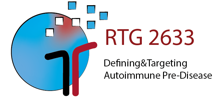Nele Wellbrock
Novel target antigens as inducers of autoimmunity of bullous autoimmun dermatoses
Blistering autoimmun dermatoses (BAID) include a group of rare skin diseases characterized by autoantibodies directed against different structural proteins of the skin and/or the mucous membrane. As these proteins are responsable for cell-cell contacts of keratinocytes and therefore for the stability of the skin, the damage of these structural proteins lead to skin blistering. BAID can be classified into two groups depending on the target antigens. First there can be autoantibodies against desmosomal proteins mostly desmoglein 1 and 3 which cause intraepidermal clefts (pemphigus group). And second there can be autoantibodies against structural proteins in the dermo-epidermal junction such as BP180, BP230, laminin 332 a6b4-integrin and type V|| collagen which split the epidermis and dermis (pemphigoid group). The gold standard for the diagnosis is the direct immunofluorescence with which IgG/IgA/ IgE/IgM and/or C3 of a perilesional skin biopsy can be detected. For a differentiation between the various types of BAID, the characterization of the autoantibodies by indirect immunofluorescence, ELISA, biochips and immunoblotting is necessary. Although the pathophysiology seems to be well understood, there are some patients with the clinical picture and whose biopsy shows positive antibodies in immunofluorescence, but no antigen could be identified. So there might be some yet undetected early events in the development stage of the disease. The identification of further antigens can help to develop new therapies in early stages of the disease. In this project it is planned to test autoantibody reactivity of sera which will be prepared differently before. If there might be a finding of a protein, it will be recombinantly produced followed by different tests such as characterization regarding its binding region or its pathogenic potential in the skin.

- People
- Doctoral Candidates
- Merabell Adem
- Katja Adriany
- Farbod Bahreini
- Estelle Bergmann
- Swayanka Biswas
- Jana Buhre
- David De Luca Laredo
- Kaan Ersoy
- Ferdinand Gebauer
- Sen Guo
- Veronika Hartmann
- Michelle Hein
- Luise Janusch
- Maj Jäpel
- Anna Knauer
- Valentin Kneitz
- Maximilian Lahmer
- Wing Yu Lee
- Daniel Mehlberg
- Sahar Mehrabani
- Afsaneh Mehrpouyan
- Sadegh Mousavi
- Milica Novovic
- Justus Ohmes
- Bianca Opelka
- Colin Osterloh
- Cristian Papara
- Tina Rastegar Lari
- Rochi Saurabh
- Alessia Maria Sbaraglia
- Jovan Schanzenbacher
- Mareile Schlotfeldt
- Carolin Schmidt
- Solveig Lea Schmidt
- Leon Schmidt-Jiménez
- Nora Schoell
- Salomini Sinnathurai
- Sarah Stenger
- Chiara Walczyk
- Nele Wellbrock
- Julia Wimmer-Gross
- Natalia Zappe
- Jianrui Zheng
- Luca Zillikens
- Carla Zünkeler
- Principal Investigators
- Associated Scientists
- Administration
- Doctoral Candidates




